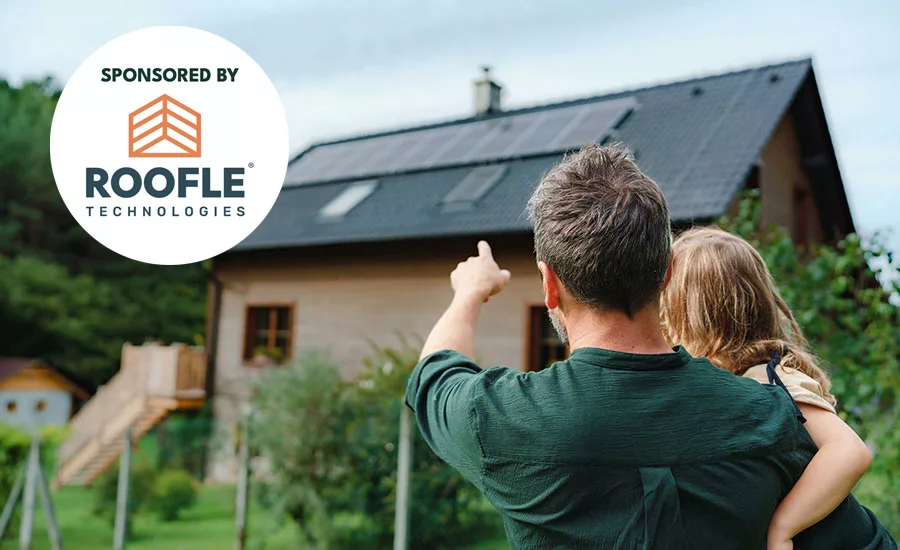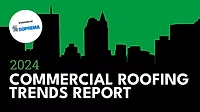Sponsored by Roofle Technologies
2024 Homeowner Roofing Survey
New research highlights the roofing customer’s journey, and where their expectations align with roofing contractors — and where they don’t

The health of the housing market in the United States has the potential to impact the success of roofing contractors each and every year. That said, savvy roofers can still set themselves up for a profitable year even with overarching concerns like lingering inflation, high interest rates and increased material prices slowing down the pace of new builds in early 2024.
The keys to making that happen include understanding the changing marketplace; meeting the needs of a new generation of home buyers; and optimizing workforce, according to new research conducted on behalf of RC by the experts from Clear Seas Research — the survey and research arm of RC’s parent company, BNP Media.
The following 2024 Homeowner Trends Survey Report, sponsored by our partners at Roofle Technologies, highlights the key findings from a thorough analysis of responses.
For more than a decade, RC has surveyed roofing contractors and industry stakeholders with its research partners in order to provide insights into the issues, products and innovations driving the marketplace.
For the first time, RC included questions geared toward homeowners with the intent to better equip roofing contractors in any market with information to excel. The findings and corresponding insight from experts sought out by RC can help roofers understand the contractor selection process, the purchasing decisions residential customers make, and where homeowner expectations align with their own. And, perhaps more importantly, where they don’t.
Join RC and its research partners from Clear Seas Research and Roofle Technologies to see where roofers are doing well and where they can grow and improve during a free, live webinar on the 2024 Homeowner Trends Survey at roofingcontractor.com. Clear Seas Research CEO Mitch Henderson and members of the Roofle leadership team will present the report’s findings and offer analysis during a seminar titled “2024 Homeowner Trends” at 2 p.m. Thursday, May 23.
Residential Sweet Spot
Before diving into the data, let’s set the stage for the survey circulated online last fall. The target audience was homeowners involved in decisions surrounding roofing at their residences. Each respondent received a $5 gift card for their participation. Here’s a closer look at this year’s survey field.
Homeowners reported a median annual household income between $100,000 and $149,999. The majority of respondents were men (76%), and the average homeowner age was 57; however, the sample field included responses from baby boomers (49%), Gen X (31%) and millennials (18%). That lines up with new home-buying demographics from 2023, according to the National Association of Home Builders.
Among generations, Boomers accounted for the largest overall home-buying share at roughly 39%, the NAHB noted in its annual report released in February. That’s a sizeable increase from the previous year and well ahead of millennials, which factored in at 28%. That doesn’t account for the lucrative reroofing and storm replacement markets, which roofing contractors are banking on for projected sales this year and beyond.
According to data acquired for RC’s 2024 State of the Industry Report, 63% of contractor respondents expected an increase in residential business, while 67% say residential roofing sales will rise through 2027.
According to the homeowner data, roofing contractors will have to be relatively easy to locate in order to achieve that.
The vast majority of Homeowner Survey respondents (73%) indicated they are most likely to seek out a roofing company via word of mouth/recommendation. Next was search engine results (54%), followed by using a contractor they’ve worked with before.
These findings partially matched where roofers said they were spending their advertising dollars. Word-of-mouth and recommendations led (83%), followed by social media ads (60%), home services websites (36%) and Google ads (33%).
The power of online reviews also emerged in the data, with 34% of homeowners saying they are "very important" to their purchasing decisions. Another 31% found reviews important, and 30% said it was extremely important. Just a combined 5% found reviews of little to no importance.
Roofing contractors appear to be paying attention to the importance of reviews, with about 68% indicating they feature online reviews on their company websites. Still, about 21% said they don’t include reviews, and the majority of those were smaller-sized businesses with fewer than 10 employees.
Once they find a roofing contractor, the data suggests homeowners have lofty expectations when it comes to response and lead times. Almost all (97%) said they expect a response from a roofing contractor within a week, and more than half (54%) placed a premium on one-to-two days. Just 2% said they expect same-day responses. About 80% of contractors said they responded within that initial week, and more than half (54%) agreed that responding within two days was a priority.
Overall, homeowners indicated the time between obtaining a quote and the job starting is one to three weeks. About 43% said they expected one week to 13 days, 40% said between two and three weeks, and 9% said they expected work to start in less than a week. A combined 64% of contractors surveyed said between one and three weeks is their current lead time.
Digital Trends
Along with the growing importance of online reviews to homeowners and contractors alike, other digital tools are impacting consumer decision-making.
When it comes to paying for a new roof, homeowners indicated that they prefer to use a credit card (40%) followed by a check (31%). Just 9% indicated using cash, roofing contractor financing, or financing through another lender as their preferred option.
More than three-quarters of roofing contractors indicated they offer credit card payment services. Less than half (44%) said they offer other financing options like home equity and bank or personal loans, and just 38% said they offer financing as a roofing company.
How roofing companies communicate is also making a difference. When asked about preferred communication methods, most homeowners said they prefer phone calls (46%), followed by 39% prefer email, and 15% prefer text. Preferences also seemed to follow generational lines. According to the data, more than half of baby boomers (53%) said they wanted phone calls from roofers, while less than half of millennial homeowners (43%) preferred that method. Generation X wanted the least phone contact (36%), preferring emails the most (44%) as well as texts (21%). About 39% of millennials liked emails, while fewer preferred texting (17%). Just 35% of boomers said they wanted emails; only 11% preferred text.
One digital tool that homeowners indicated they wanted but weren’t likely to get from many roofing contractors is price listing or transparency on company websites. Roughly two-thirds of homeowners (66%) said they’re more likely to call a roofing contractor that offers pricing on the company website. About 31% said it wouldn’t make a difference, and just 2% indicated online pricing would make them less likely to call.
The potential disconnect between roofers and consumers' stated preference for online pricing becomes clearer, as barely one-quarter of roofers (28%) said they offer pricing online.
Breaking down the numbers further by generation said a lot about shifting expectations when it comes to pricing and online purchases. About 74% of millennials and 72% of Gen Xers said they’re more likely to call roofers with pricing available online, while 61% of boomers agreed. Roughly 39% of boomers said it would make no difference to a hiring decision, as did 28% of Gen X. Just 13% of millennials said it would make no difference.
About 96% of contractors identified as baby boomers said they don’t offer pricing, followed by Gen X (71%) and millennials (65%).
ROOM TO GROW
So where do roofing contractors find room to improve? The data indicates some specific product areas — such as metal and solar — that offer growth opportunities for the right roofing contractors looking to capitalize.
Asphalt shingles remained the most popular and common among homeowners surveyed, yet it was at 56%, leaving opportunities for growth. The majority of respondents also said their commitment to asphalt is strong, with 63% indicating they would not switch to another roofing system.
One quarter of homeowners said they’ve considered switching to metal roofs, and about 12% said they’ve considered composite shingles. About one-third said they’re interested in solar roofing, with the majority of those households located in Western states.
One other area where all roofers could see revenues improve is through service agreements. Only 28% of homeowners found roof maintenance agreements either very or extremely important, yet the data suggests a strong majority would be willing to pay for preventative maintenance agreements. Among them, 89% said they’d be willing to pay between $100-$500 annually for such agreements, yet not even two-thirds of all roofing contractors currently offer them.
Another potential opportunity contractors can derive from the data relates to job quotes. About 94% of customers said they’d receive up to three quotes for a roofing project, 67% of whom specifically seek three before selecting a contractor. More than three-quarters (78%) of contractors surveyed said they do not charge a visit fee for a roof assessment.
Perhaps the most telling data set for roofing contractors to follow is what factors ranked most important when it came to the homeowner’s hiring decision.
More than half (61%) found company reputation the leading factor, and 50% ranked experience and licensing next. When asked specifically in terms of most important, the four leading factors that homeowners use to select a roofing contractor are: company reputation (31%); professional licensing (16%); contractor experience and quality of materials (each 13%). Insurance coverage, long-term warranties and low-cost bids all factored in at less than 10%, the data showed.

JamesBrey/iStock / Getty Images Plus via Getty Images
Homeowner Trends Roofers Need To Know
What: A must-attend for all roofing contractors who are looking for:
- A better understanding of homeowner expectations for residential roofing contractors when it comes to the overall experience of purchasing a roof.
- Data-driven insight into where those expectations align with roofing contractors – and where they don’t.
- Market insight related to current and future trends in residential roofing.
- Exclusive viewpoints into current and future growth opportunities for contractors.
- Understanding what factors influence the contractor selection process.
- Ideas to improve customer communication and operational efficiency that grow profits.
When: 2 p.m., Thursday, May 23
Presenters:
- Mitch Henderson, co-CEO, BNP Media, Clear Seas Research
- Travis Harvego, CEO, Roofle Technologies. Harvego has more than 10 years of hands-on field experience in customer relationship management, sales, sales management, project management and labor relations.
Mike Goldenstein, chief revenue officer, Roofle Technologies. With over 30 years in the roofing industry, Goldenstein is a voice contractors trust, and he excels at advocating for industry success and advancement.
Chris Morris, CEO at Stonegate Group LLC. Morris boasts extensive expertise in roofing, digital marketing and AI-driven sales automation.
To Do: Register now for free here
Editor’s Note: The information contained within this article comes from Clear Seas Research and the 2023 Roofing Customer Journey Report, completed in October 2023.
Clear Seas Research is a full-service, B-to-B market research company focused on making the complex clear. Custom research solutions include brand positioning, new product development, customer experiences and marketing effectiveness solutions. Clear Seas offers a broad portfolio of primary, syndicated research reports and powers the leading B-to-B panel for corporate researchers, myCLEARopinion Panel, in the architecture, engineering, construction, food, beverage, manufacturing, packaging and security industries. Learn more at clearseasresearch.com.
Looking for a reprint of this article?
From high-res PDFs to custom plaques, order your copy today!






